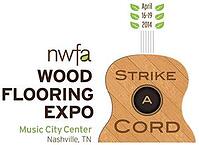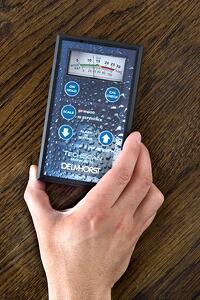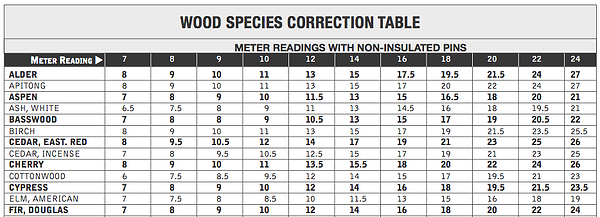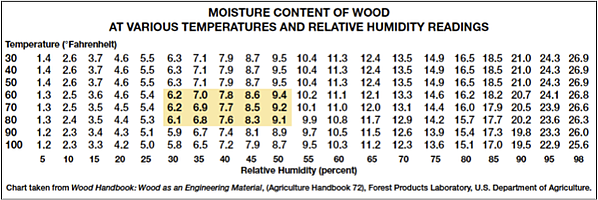 This year’s NWFA Wood Flooring Expo was a huge success! We got to speak with many flooring professionals at our booth, and the feedback about Delmhorst meters was overwhelmingly positive. The J-2000 is one of the most widely used pin-type moisture meters in the flooring industry, and there’s a lot of interest from flooring installers and inspectors to add the new TechScan and ProScan pinless moisture meters to their toolbox.
This year’s NWFA Wood Flooring Expo was a huge success! We got to speak with many flooring professionals at our booth, and the feedback about Delmhorst meters was overwhelmingly positive. The J-2000 is one of the most widely used pin-type moisture meters in the flooring industry, and there’s a lot of interest from flooring installers and inspectors to add the new TechScan and ProScan pinless moisture meters to their toolbox.
 With many of these professionals carrying both types of meters and others interested in learning how they can help improve their installing or inspection business, I presented a “Using Moisture Meters for Flooring” educational seminar at the expo.
With many of these professionals carrying both types of meters and others interested in learning how they can help improve their installing or inspection business, I presented a “Using Moisture Meters for Flooring” educational seminar at the expo.
The presentation spawned great conversation about effective use of moisture meters on the job site. I received a lot of positive feedback and thought it would be valuable to share the key takeaways from the presentation for those who were unable to attend.
What Factors Affect a Meter Reading Besides Moisture Content?
- Species
- Specific gravity
- Wood temperature
- Moisture content range
- Moisture content gradient
- Presence of wet pockets
- Surface moisture
- Sample size (width and thickness)
- Surface quality
No matter what meter you choose, to achieve the best accuracy, you have to be aware of, and be able to compensate for, the factors that affect your readings.
Species Correction vs. Specific Gravity
Knowing when each of these corrections is necessary is important to achieve precise moisture content readings at the job site. The first question you need to ask is: What type of meter are you using?
When utilizing a pin-type moisture meter, a species correction factor is required. The accuracy of pin meters is greatly affected by different types of wood, because all species yield different readings at the same moisture content. This is because the electrical characteristics of different wood species vary. Wood species correction tables for Delmhorst pin-type meters can be found here. Some Delmhorst meters, like the J-2000, have built-in species corrections, which allow you to set the species being tested, with the meter making the correction internally.
 Pinless meters also yield different readings for different wood species. However, instead of the electrical characteristics of the different species affecting the readings, it is the wood density that affects the readings. Pinless moisture meters must be corrected for specific gravity (also referred to as density compensation) to yield reliable results. ProScan has the ability to internally correct for specific gravity, much like species correction in a pin-type meter.
Pinless meters also yield different readings for different wood species. However, instead of the electrical characteristics of the different species affecting the readings, it is the wood density that affects the readings. Pinless moisture meters must be corrected for specific gravity (also referred to as density compensation) to yield reliable results. ProScan has the ability to internally correct for specific gravity, much like species correction in a pin-type meter.
When You Don’t Have Species Correction
What do you do if you’re working on a flooring job installing an exotic wood species that is not listed on the correction charts? Is your pin-type moisture meter still useful? Yes. A good moisture meter is still valuable, even without a correction factor, because you can use it to determine the equilibrium moisture content (EMC).
 To determine the EMC, cut a sample size of the material and hang it at the job location. Set your meter at default and take daily readings until the moisture content does not change. Then you know that you are at equilibrium, and you can be confident that the species you are working with will not change dimension.
To determine the EMC, cut a sample size of the material and hang it at the job location. Set your meter at default and take daily readings until the moisture content does not change. Then you know that you are at equilibrium, and you can be confident that the species you are working with will not change dimension.
Here’s a trick of the trade: Don’t overanalyze. A meter reading by itself is not always as important as monitoring the behavior of the wood in its environment. Allowing the wood to attain its EMC level, where it won’t change its dimensions, means it won’t crack or split.
Does Surface Moisture Skew a Meter Reading?
Every meter is affected by surface moisture to some extent, though some manufacturers claim theirs are not. Readings taken with a surface meter are affected by surface moisture, making it difficult to determine if the surface moisture is a result of standing water caused by rain or if it is representative of the moisture content throughout the board.
The best way to overcome this is with a pin meter. Moisture caused by exposure to rain, fog or high relative humidity is easily and accurately detected with insulated pins. If you’re using non-insulated pins, push them 1/16" into the wood and read the meter. Then push them to their full penetration. The meter reading should increase by 1 to 2 points, because of the greater contact. If there is no increase, or if the increase is less than 1 percent, the wood is wet on the surface and the readings are unreliable.
Moisture Meters for Flooring
Moisture meters are proven, indispensible tools for flooring inspection and installation. To achieve fast, accurate results you must know the meter’s capabilities, follow the manufacturer’s procedures and, most importantly, apply your knowledge and experience.

Comments